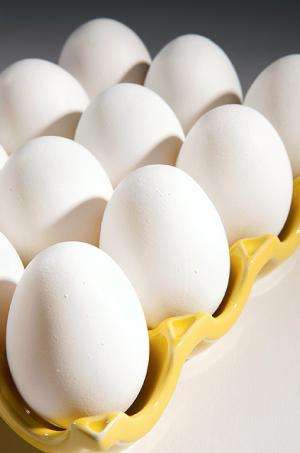Researchers develop technique for pasteurizing raw eggs

Classic Caesar salad, old-fashioned eggnog, some homemade ice cream—and many other popular foods—may contain raw eggs. Now, U.S. Department of Agriculture (USDA)-led research has produced a faster way to pasteurize raw, in-shell eggs without ruining their taste, texture, color or other important qualities.
The pasteurization procedure targets Salmonella. That's because an estimated one out of every 20,000 chicken eggs produced in the United States has a high risk of being contaminated with Salmonella, notably S. enteritidis. That pathogen has been associated with eating raw or undercooked eggs, and can cause diarrhea, stomach cramps, fever, and—in some instances—death.
USDA chemical engineer David J. Geveke and his colleagues have shown that their pasteurization process, currently in the prototype stage, killed 99.999 percent of the Salmonella that they injected into raw in-shell eggs for their laboratory tests.
When commercialized, the pasteurization procedure would provide an alternative to an hour-long hot-water-immersion process. That technique is apparently the only one already used commercially in the United States to pasteurize fresh shell eggs.
The procedure that Geveke's team developed begins with positioning each raw egg between two electrodes that send radio waves back and forth through it. While that is happening, the egg is slowly rotated, and is sprayed with water, to offset some of the heat created by the radio waves.
Unlike conventional heating, the radio-frequency (RF) heating warms the egg from the inside out. That's critical to the success of the process. It enables the dense, heat-tolerant yolk at the center of the egg to receive more heat than the delicate, heat-sensitive egg white.
A comparatively brief hot-water bath comes next. The warmth of the bath helps the yolk retain heat to complete the pasteurization. The bath also pasteurizes the egg white without overprocessing it.
From start to finish, the treatment takes approximately 20 minutes, making it about three times faster than the hot-water-immersion technique.
The idea of using RF heating to kill pathogens in foods isn't new. But using RF heating to kill pathogens in eggs apparently is novel. Geveke and his colleagues are evidently the first to pair RF heating with a hot-water bath to pasteurize raw, in-shell eggs.
Provided by Agricultural Research Service


















